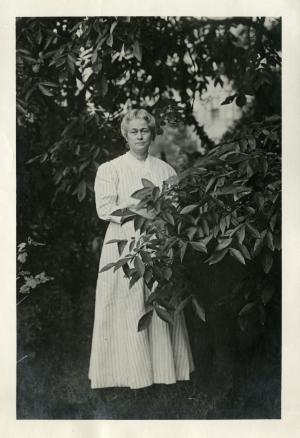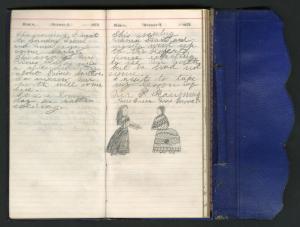Throughout March, we will be celebrating Women's History Month with photos in the Flickr Commons and a series of blog posts about women from the Archives' collections.
 Women's History Month is meant to celebrate notable, influential women who, through their activism in their chosen field, made contributions to history and society. One woman that we here at the Archives would like to highlight is Florence Merriam Bailey, an American nature writer and ornithologist who made significant contributions to ornithology through her participation and work with the National Audubon Society, the American Ornithologists' Union, and more.
Women's History Month is meant to celebrate notable, influential women who, through their activism in their chosen field, made contributions to history and society. One woman that we here at the Archives would like to highlight is Florence Merriam Bailey, an American nature writer and ornithologist who made significant contributions to ornithology through her participation and work with the National Audubon Society, the American Ornithologists' Union, and more.
As an intern with the Digital Services Division, I worked with the Florence Merriam Bailey Papers for the past seven weeks and learned a great deal about Florence's life and work and its influence on the 19th century scientific community. I have to be honest, before embarking on this project, I had little to no knowledge about the field of ornithology and had never heard of Florence's work. After looking at her various diaries, journals, publications, and photographs, Florence's passion for studying birds became very apparent to me.
Florence was the daughter of Clinton Levi Merriam and the sister of Clinton (C.) Hart Merriam, a famous zoologist who worked for and eventually became director of the U. S. Biological Survey and was first president of the American Society of Mammalogy. C. Hart Merriam introduced Florence to her future husband, Vernon Orlando Bailey, another prominent figure in the field of natural history. Vernon and C. Hart Merriam worked together compiling their research and field work and shared their work with the Smithsonian. Vernon and Florence spent their life together as a perfect team, conducting research together and taking the scientific world by storm.
 Florence was born on August 8, 1863 in Locust Grove, New York during the Civil War. At the age of eleven, she wrote a diary detailing her daily thoughts and activities in Washington, DC, where she was living at the time. In her early entries, she speaks of taking walks, attending Sunday school, and learning Latin. She was very literate and well-written by the age of eleven and cared about her studies. "I have finished all of my Sunday School lesson, but of course I will have to look it over every day." She even displayed a hint of adolescent humor in her entries, as on January 6 she states, "I have not done anything today that is worth writing down so I guess I won't say anything." I found this first diary interesting not only because I was able to read about young Florence's life but also because it was really interesting to study the physical differences in the diaries themselves from those of today. Florence also kept other diaries of her life in Washington, and journals from trips to South Carolina, Maine, California, etc. In her California journal in particular, I found that her curly, cursive writing was sometimes hard to decipher and I had to look up the places she was describing. However after working with her collection for the past several weeks, I started to become familiar with her handwriting.
Florence was born on August 8, 1863 in Locust Grove, New York during the Civil War. At the age of eleven, she wrote a diary detailing her daily thoughts and activities in Washington, DC, where she was living at the time. In her early entries, she speaks of taking walks, attending Sunday school, and learning Latin. She was very literate and well-written by the age of eleven and cared about her studies. "I have finished all of my Sunday School lesson, but of course I will have to look it over every day." She even displayed a hint of adolescent humor in her entries, as on January 6 she states, "I have not done anything today that is worth writing down so I guess I won't say anything." I found this first diary interesting not only because I was able to read about young Florence's life but also because it was really interesting to study the physical differences in the diaries themselves from those of today. Florence also kept other diaries of her life in Washington, and journals from trips to South Carolina, Maine, California, etc. In her California journal in particular, I found that her curly, cursive writing was sometimes hard to decipher and I had to look up the places she was describing. However after working with her collection for the past several weeks, I started to become familiar with her handwriting.
 This collection also includes a vast collection of field notes and photographs from her expeditions. One trip in particular caught my eye. Florence's 1898 trip to Mount Hood in Oregon was interesting to work with because it included both field notes as well as photographs. This made it easy to visualize the places and species she wrote about. She also took photos of the mountain itself as well as of the bird habitats in the area, including trees and bushes.
This collection also includes a vast collection of field notes and photographs from her expeditions. One trip in particular caught my eye. Florence's 1898 trip to Mount Hood in Oregon was interesting to work with because it included both field notes as well as photographs. This made it easy to visualize the places and species she wrote about. She also took photos of the mountain itself as well as of the bird habitats in the area, including trees and bushes.
One of my favorite groups of photographs and documents are those from "Homewood." Homewood was Florence's name for the family property in Locust Grove, New York. She documents the house and land via black-and-white photographs. I particularly enjoyed the pictures of "Brownie," a squirrel that was often present in Homewood. Florence seemed to enjoy taking pictures of him, as there are several within her collection of him in a variety of amusing poses.
 I enjoyed this collection for its variety of field documents and photographs, both in the field as well as personal ones. Through interacting with Florence's diaries, field books, and photographs I was able to connect at a personal level with this inspiring woman of the scientific community. Florence was not only a researcher of birds, but a promoter of their preservation too. She became involved with the Committee on Bird Protection of the American Ornithologists' Union, and as a result of her efforts and others, the Lacey Act of 1900 was instituted. This act prohibited interstate trade in wildlife that had been illegally taken, transported or sold. Florence Merriam Bailey was a prominent historical figure in the field of ornithology and an inspiring woman.
I enjoyed this collection for its variety of field documents and photographs, both in the field as well as personal ones. Through interacting with Florence's diaries, field books, and photographs I was able to connect at a personal level with this inspiring woman of the scientific community. Florence was not only a researcher of birds, but a promoter of their preservation too. She became involved with the Committee on Bird Protection of the American Ornithologists' Union, and as a result of her efforts and others, the Lacey Act of 1900 was instituted. This act prohibited interstate trade in wildlife that had been illegally taken, transported or sold. Florence Merriam Bailey was a prominent historical figure in the field of ornithology and an inspiring woman.
Related Collections
- Record Unit 7417 - Florence Merriam Bailey Papers, 1865-1942, Smithsonian Institution Archives
- Record Unit 7267 - Vernon Orlando Bailey Papers, 1889-1941 and undated, Smithsonian Institution Archives
Related Resources
- Comparing Observations: Vernon and Florence Merriam Bailey, Smithsonian Collections blog
- A Beaver Corral, Fried Owl, and Pueblos: Adventures with Vernon Orlando Bailey, The Bigger Picture blog, Smithsonian Institution Archives
Produced by the Smithsonian Institution Archives. For copyright questions, please see the Terms of Use.

Leave a Comment